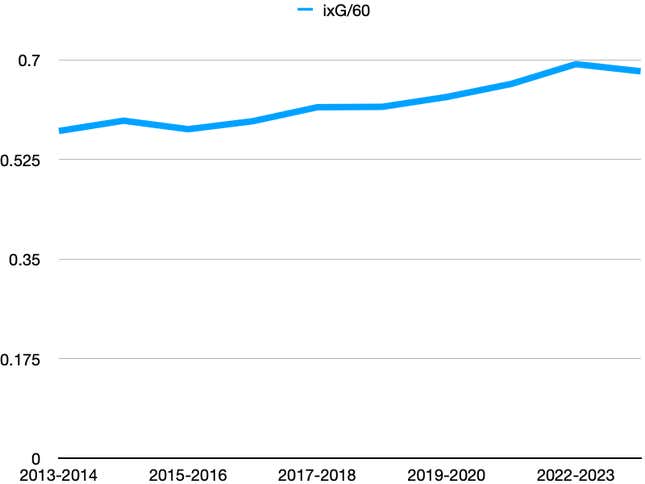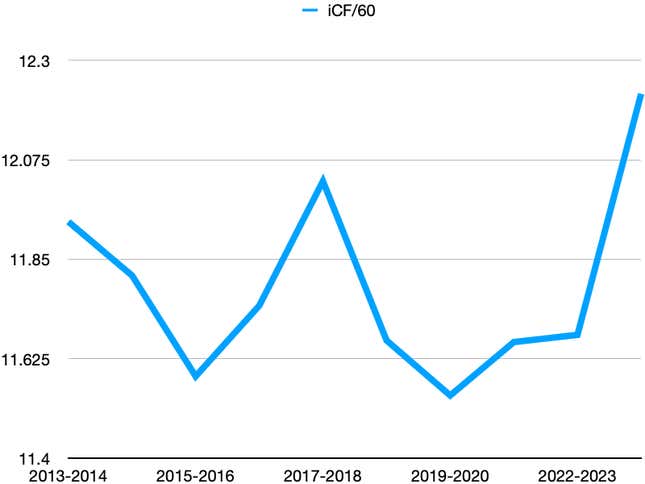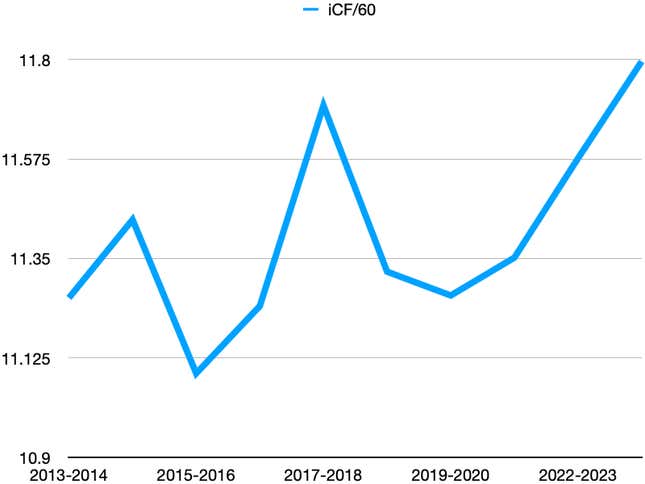The NHL is at all times chasing objectives. Typically to its detriment, because the league usually confuses objectives with motion. What the league actually desires is to assign the Useless Puck Period to the land of wind and ghosts eternally, which it just about has. It desires a quick sport exhibiting off the talents of gamers and never the power of some plug to easily waterski behind all these which are higher and quicker than him, which it just about has. There’s little query the league has extra talent in it than ever, which is simply the evolution of any sport. Your favourite participant from 1992 would virtually definitely have their coronary heart explode after a pair shifts in in the present day’s sport (Pavel Bure may sustain, although).
By that, scoring has been up for a couple of years now, although a contact down from final yr. Groups are averaging 3.10 objectives this yr, versus 3.18 final yr, however that’s nonetheless a 13 % enhance from 10 years in the past (2.74 objectives per sport per workforce). Over at The Athletic on Tuesday, Murat Ates and Fluto Shinzawa attempt to get to the guts of why scoring is up and save percentages are down up to now decade.They accomplish that by means of the eyes of a pair goalies, centered on the Jets’ Connor Hellebuyck, one of many main contenders for this yr’s Vezina Trophy (finest goalie).
A number of elements are talked about, and so they all play an element. Definitely the crackdown on goalie gear has performed an enormous position, as netminders aren’t popping out to the ice trying just like the Keep Puft Marshmallow Man anymore. There are simply extra holes to be discovered on them. Analytics is one other, as groups know the place the most effective chances are high produced from and are focusing their play on attending to these spots and creating these possibilities.
One other is the rise in particular person talent on each workforce. Groups now don’t essentially have two scoring traces, a checking line, after which a palooka-filled fourth line that coaches and followers alike cowl their eyes and conceal behind chairs after they take the ice. That is in all probability a development that ought to have occurred some time in the past, as there was at all times a bonus to be gained by making an attempt to ice third and fourth traces that had a pace and talent benefit over groups nonetheless clinging to the concept a fourth line may solely be an “power line” (*cough*Lou Lamiorello *cough*). The wage cap has made that difficult to drag off, however with increasingly youngsters coming by means of the draft who’re merely higher ready to play a quicker and extra expert sport, we’re getting there.
However by how a lot? That is what piqued my curiosity. So we’re gonna get chart-y. It’s an admittedly crude technique, however I took the ahead analytic knowledge from the previous 10 seasons (throwing out the season in a silent can of 2020-2021) from NaturalStatTrick.com after which lower off the highest quarter in common ice-time per sport, basically the highest traces of each workforce. Once more, not good, however the most effective I may provide you with (man, do I want I paid consideration in these math lessons as a substitute of prepping for a stand-up profession that might solely yield tepid outcomes, at finest). After which I lower off the highest half of forwards in ice-time per sport, making an attempt to concentrate on solely the underside six forwards within the league.
To attempt to lower out what impact shrinking goalie pads have had over the previous 10 years, it’s finest to have a look at particular person anticipated objectives per 60. That stat solely has to do with the place the photographs are coming from, not whether or not they’re saved. Have been forwards under the highest line producing extra and higher possibilities over the previous 10 seasons?
Properly, right here’s the way it appears to be like for forwards on the 2nd-4th traces:
That’s a fairly regular incline for gamers not averaging probably the most time on ice. It’s a 15 % enhance from what these forwards averaged by way of ixG/60 in 13/14 (.609) to this season (.703).
What about simply the underside six?

My chart expertise aren’t what they need to be, so whereas that appears like much less of a rise, it truly isn’t. 10 years in the past, forwards averaging the underside half of ice time put up 0.575 ixG/60. This yr it’s 0.68, which is an 18.2 % enhance from 10 years in the past.
So far as straight makes an attempt, which additionally wouldn’t be affected by goalie pads, there’s slightly extra volatility in these, however nonetheless the identical type of enhance. Because the Athletic article factors out, groups aren’t as centered on quantity of makes an attempt and photographs nowadays as they had been 10 years in the past when each workforce needed to be the Kings and dump the puck in, win it again, get it to the factors and bomb away to create a ruckus across the crease (or principally what the Hurricanes nonetheless do). Right here’s the person Corsi for traces 2-4:

After which simply backside sixers:

Extra of a gradual rise from the final group there, with a spike from the primary group this season. However we will see that groups on all their traces are concentrating on higher possibilities even whereas getting a rise in makes an attempt.
Whereas some followers might bemoan the lack of the grind/sandpaper/FAAAAAART sections of their roster, as extra third and fourth liners are expert gamers now, what they really are is simply capable of do every little thing. Possibly they don’t hit as a lot, however that doesn’t imply they will’t get down within the corners and win the puck again, which is on the coronary heart of hitting and checking, and received slightly misplaced. And quicker gamers are more durable to hit, clearly.
It’s good for the league that extra gamers can do extra issues, and that the talent degree is rising all through the league. And don’t fear, those that nonetheless cling to their Chris Draper dolls will quickly be useless anyway.


